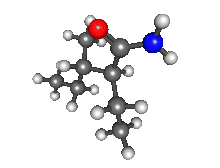
| |

| |
| Names | |
|---|---|
| Preferred IUPAC name
2-Ethyl-3-methylpentanamide[1] | |
| Identifiers | |
3D model (JSmol)
|
|
| ChEMBL | |
| ChemSpider | |
| ECHA InfoCard | 100.021.849 |
| EC Number |
|
| KEGG | |
| MeSH | valnoctamide |
PubChem CID
|
|
| RTECS number |
|
| UNII | |
CompTox Dashboard (EPA)
|
|
| |
| |
| Properties | |
| C8H17NO | |
| Molar mass | 143.230 g·mol−1 |
| Appearance | White crystals |
| log P | 1.885 |
| Pharmacology | |
| N05CM13 (WHO) | |
| |
| Pharmacokinetics: | |
| 94% | |
| Hepatic | |
| 10 hours | |
| Hazards | |
| GHS labelling: | |

| |
| Warning | |
| H302 | |
| Lethal dose or concentration (LD, LC): | |
LD50 (median dose)
|
760 mg kg−1 (oral, rat) |
| Related compounds | |
Related alkanamides
|
Valpromide |
Related compounds
|
|
Except where otherwise noted, data are given for materials in their standard state (at 25 °C [77 °F], 100 kPa).
| |
Valnoctamide (INN, USAN) has been used in France as a sedative-hypnotic since 1964.[2] It is a structural isomer of valpromide, a valproic acid prodrug; unlike valpromide, however, valnoctamide is not transformed into its homologous acid, valnoctic acid, in vivo.[3]
Indications[edit]
In addition to being a sedative, valnoctamide has been investigated for use in epilepsy.[4][5][6]
It was studied for neuropathic pain in 2005 by Winkler et al., with good results: it had minimal effects on motor coordination and alertness at effective doses, and appeared to be equally effective as gabapentin.[7]
RH Belmaker, Yuly Bersudsky and Alex Mishory started a clinical trial of valnoctamide for prophylaxis of mania in lieu of the much more teratogenic valproic acid or its salts.[8]
Side effects[edit]
The side effects of valnoctamide are mostly minor and include somnolence and the slight motor impairments mentioned above.
Interactions[edit]
Valnoctamide is known to increase through inhibition of epoxide hydrolase the serum levels of carbamazepine-10,11-epoxide, the active metabolite of carbamazepine, sometimes to toxic levels.[9]
Chemistry[edit]
Valnoctamide is a racemic compound with four stereoisomers,[10] all of which were shown to be more effective than valproic acid in animal models of epilepsy and one of which [(2S,3S]-valnoctamide) was considered to be a good candidate by Isoherranen, et al. for an anticonvulsant in August 2003.[11]
Butabarbital can be hydrolyzed to Valnoctamide.[12]
References[edit]
- ^ "valnoctamide - Compound Summary". PubChem Compound. USA: National Center for Biotechnology Information. 26 March 2005. Identification and Related Records. Retrieved 20 February 2012.
- ^ Harl, F. M. (March 1964). "[Clinical Study Of Valnoctamide On 70 Neuropsychiatric Clinic Patients Undergoing Ambulatory Treatment]". La Presse Médicale (in French). 72: 753–754. PMID 14119722.
- ^ Haj-Yehia, Abdullah; Meir Bialer (August 1989). "Structure-pharmacokinetic relationships in a series of valpromide derivatives with antiepileptic activity". Pharmaceutical Research. 6 (8): 683–689. doi:10.1023/A:1015934321764. PMID 2510141. S2CID 21531402.
- ^ Mattos Nda, S. (May 1969). "[Use of Valnoctamide (nirvanil) in oligophrenic erethics and epileptics]". Hospital (Rio J) (in Portuguese). 75 (5): 1701–1704. PMID 5306499.
- ^ Lindekens, H.; Ilse Smolders; Ghous M. Khan; Meir Bialer; Guy Ebinger; Yvette Michotte (November 2000). "In vivo study of the effect of valpromide and valnoctamide in the pilocarpine rat model of focal epilepsy". Pharmaceutical Research. 17 (11): 1408–1413. doi:10.1023/A:1007559208599. PMID 11205735. S2CID 24229165.
- ^ Rogawski, MA (2006). "Diverse mechanisms of antiepileptic drugs in the development pipeline". Epilepsy Res. 69 (3): 273–294. doi:10.1016/j.eplepsyres.2006.02.004. PMC 1562526. PMID 16621450.
- ^ Winkler, Ilan; Simcha Blotnik; Jakob Shimshoni; Boris Yagen; Marshall Devor; Meir Bialer (September 2005). "Efficacy of antiepileptic isomers of valproic acid and valpromide in a rat model of neuropathic pain". British Journal of Pharmacology. 146 (2): 198–208. doi:10.1038/sj.bjp.0706310. PMC 1576263. PMID 15997234.
- ^ RH Belmaker; Yuly Bersudsky; Alex Mishory; Beersheva Mental Health Center (2005). "Valnoctamide in Mania". ClinicalTrials.gov. United States National Institutes of Health. Retrieved 25 February 2006.
- ^ Pisani, F; Fazio, A; Artesi, C; Oteri, G; Spina, E; Tomson, T; Perucca, E (1992). "Impairment of carbamazepine-10, 11-epoxide elimination by valnoctamide, a valpromide isomer, in healthy subjects". British Journal of Clinical Pharmacology. 34 (1): 85–87. doi:10.1111/j.1365-2125.1992.tb04114.x. PMC 1381382. PMID 1352988.
- ^ Shimon Barel, Boris Yagen, Volker Schurig, Stephan Sobak, Francesco Pisani, Emilio Perucca and Meir Bialer. Stereoselective pharmacokinetic analysis of valnoctamide in healthy subjects and in patients with epilepsy. Clinical Pharmacology & Therapeutics 61, 442–449 (April 1997) doi:10.1016/S0009-9236(97)90194-6
- ^ Isoherranen, Nina; H. Steve White; Brian D. Klein; Michael Roeder; José H. Woodhead; Volker Schurig; Boris Yagen; Meir Bialer (August 2003). "Pharmacokinetic-pharmacodynamic relationships of (2S,3S)-valnoctamide and its stereoisomer (2R,3S)-valnoctamide in rodent models of epilepsy". Pharmaceutical Research. 20 (8): 1293–1301. doi:10.1023/A:1025069519218. PMID 12948028. S2CID 20755032.
- ^ Freifelder, Morris; Geiszler, Adolph O.; Stone, George R. (1961). "Hydrolysis of 5,5-Disubstituted Barbituric Acids". The Journal of Organic Chemistry. 26 (1): 203–206. doi:10.1021/jo01060a048. ISSN 0022-3263.